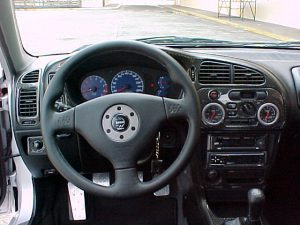Lancia Delta Integrale history and technical infos
There are things in life that reach a legendary status for various reasons. The Lancia Delta Integrale, more than any other car, has reached this status partly because of its complete dominance of the rallying world for many successive years and partly because of the outraging looks of the Evoluzione models. Being a legend does not, of course, imply this car drives better than another, simply there’s a certain aura around it that makes most people fall in love with it or, to say the least, arouses their curiosity.
It is not easy for a novice to find his way through the different Delta Integrale models that were produced over a relatively long period so here’s a very brief description:
All models where based on the original Lancia Delta that was designed by Giorgio Guigiaro in 1979 who produced a remarkably time-resistant design. The chassis used was an evolution of the Fiat Ritmo’s.
- The original model, launched during May 1986, was very close to a “normal” Delta with the addition of 4WD and a turbocharged engine. That was the Delta 4WD. It looked very close to the basic Delta but was a whole different car to drive. Its 2lt, 8 valve engine had an output of 165Bhp (150 in its “green” version).
- Then, in November 1987, came the Integrale 8V followed, in May 1989, by the Integrale 16V. These models had wider wheel arches and modified suspension settings (although the basic geometry and layout remained the same) and more powerful engines (185Bhp for the 8V, 200Bhp for the initial 16V). Some countries, like Switzerland and Germany, would only import catalytic (green) engines. Lancia were not able (willing?) to produce a 16V catalyst equipped engine so they marketed special editions of the 16V and initial Evoluzione models in which they fitted an 8V catalytic engine (178Bhp).
- In October 1991 Lancia produced the first Evoluzione model, sometimes referred to as Deltona. The car had a much wider body, different front suspension attachment points, longer suspension travel, additional air intakes, wider track, bigger front brakes with 4 pot aluminum calipers and a radiator to cool the power steering fluid among other minor changes. The Delta Evoluzione was fitted with a 16V engine that had an output of 210Bhp. The “green” countries still imported the Evoluzione fitted with an 8V engine and only 185Bhp. The Evoluzione I unfortunately maintained the undersized 15″ wheel but added 5 spoke hubs and a different, stronger, wheel design.
- By June 1993 Lancia managed to produce a catalytic converter equipped version of the 16V engine and fitted it in the Evoluzione II . It had an output of 215Bhp, new engine management (still the excellent Magneti-Marelli IAW but running at 8MHz and using double the memory capacity compared to the previous ECU), a more sophisticated knock sensor was fitted to the engine bloc, a double ignition coil with dual outputs on each coil and contact-less ignition and, finally, 16″ wheels. This version was not used as an FIA GroupA homologation special so Lancia took the opportunity to produce a more civilized and progressive car. A smaller turbocharger was fitted, as compared to previous versions, and this resulted in less turbo lag but also less engine responsiveness in high revs. The Evoluzione II is significantly less performing than its predecessor but far more driver friendly and pleasant to drive on an everyday basis. The Evoluzione II Kat version is sometimes, wrongly, referred to as Evoluzione III.
The last Delta Integrale left the Maggiora factory in November 1994.
Comparing the initial Delta 4WD to the Evoluzione II can help you realize the stages of development the Lancia Integrale went through. Eight years on steroids added a whole 10cm to the front and rear tracks of the car. The Lancia’s width grew by some 15cm! during the same period. Note also that the Evoluzione series of the Integrale are as wide and use the same track width as current WRC class cars! Finally the 2lt engine’s output gained a whole 30% over 7 years of development evolving from the original 165Bhp to 215Bhp.
Basically all the models use the same transmission, 4WD train, engine bloc and suspension geometry. What differentiates them is mainly the engine’s output and management and of course the chassis. The Evoluzione models are the ones that display the best handling characteristics and feel more “reassuring” to the driver. Previous models, although very quick and impressive, have a certain savageness and unpredictability in them at the limit of grip.
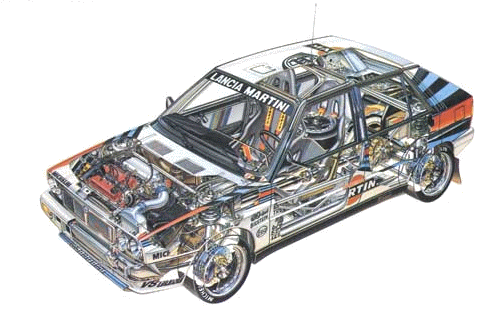
The Integrale 8V in its Group A version.
Lancia is the most successful manufacturer in world rallying ever. The company has more than 74 victories on its account and 11 World Rally Championships (6 won with the Integrale, a unique figure in the WRC for any car). The Delta Integrale, all versions combined, has scored 46 WRC wins, another unique and unmatched figure. Naturally Lancia was the manufacturer best prepared to face the shift from Group B to Group A in 1987. They had a production car, at the time, which was far better suited for rallying than any other on the market. This car was the Delta 4WD. It naturally won all the main events the year Group B cars where banned (1986) and became world champion in 1987. It evolved, through the years (from 1987 to 1992) to be called Integrale then Integrale 16V and finally Integrale Evoluzione. It won 6 world rally championships far more than any other car. Lancia being the most serious manufacturer to have ever taken part in rallying the best drivers have driven for them: Kankkunen, Biasion, Auriol, Alen, Toivonen, Röhrl and even Carlos Sainz, they have all been behind Lancia steering wheels. Lancia is also the most successful team in the WRC with cars such as the Stratos – 17 WRC wins, 037 (a.k.a. Rally) – 6 WRC wins, the Delta S4 in Group B – 5 WRC wins and the Delta Integrale in Group A – 46 WRC wins. We’ll only deal with the latter in the next pages.
Lancia has been a Fiat owned company for many years now. Fiat also owns Ferrari, Alfa Romeo, Innocenti and now Maserati. Their marketing strategy was to engage Ferrari in F1, Alfa Romeo in the Touring Car Championship and of course Lancia in the WRC. Another effect of Fiat’s ownership was the use of Fiat engines in the cars of all the other manufacturers. The engine that was chosen for the Integrale was the Fiat 2lt Turbo boosted inline 4. This engine, designed originally by Aurelio Lampredi (a genius who engineered Ferrari’s first engines back in 1947 and subsequently worked for FIAT/Abarth until 1982), was built around a dual camshaft head. Variations of the Lampredi engine were used, previously, in lots of Fiat and other Fiat owned cars like the Fiat 124, 125, 131, Ritmo, Lancia Beta and Delta. Check out the engine and Integrale 16V specs. The specs of the Integrale 8V are here, the Evoluzione specs here and Lancia rally car pictures here. The Lancia Delta Integrale uses a long stroke engine (bore smaller than stroke) favoring low rev torque over high rev output. This might seem to you as an atheism but, having owned both an 8V version and an Evolution II Cat (16V), I believe (and I’m not alone) that the 8 valve version of this engine is more fun to drive. This engine (the 8V) has a more “savage” feeling in it while under 5000rpm than the 16V versions. Remember that the 8V engine uses a larger turbocharger which introduces more lag but delivers substantial benefits in terms of driving pleasure. Of course the 16V version has more “life” in it above the 5000rpm mark. One last word on the Integrale’s engine. The unit has the peculiarity of using two balancing, counter rotating shafts in order to filter out vibrations that are inherent to 4 cylinder inline engines. These shafts were not used in competition engines.
Production-wise the number of cars produced by Lancia is:
- 1986/1987 7,665 units (4WD)
- 1988/1991 23,004 units (8V and 16V)
- 1991/1993 5,619 Evoluzione I
- 1993/1994 Evoluzione II 4,223
A grand total of 47,787 cars where produced.
Compare this number to the total of 7,145 Ford Escort RS Cosworth units.
When Lancia dominating rallying, with the Integrale (86-93), the rally world was a bit less sophisticated than it is nowadays. No computer controlled differentials, for instance, were used in races at that time, they were being developed then. So the Integrale was a solid car (compared to the “fragile” at the time Escort RS Cosworth) that managed to end most of the races it took part in.
The Delta was very remotely based on the S4 Group B car (or was it the other way around…). It’s main innovation, technically, was the use of a Torsen (which stands for Torque Sensing) rear differential. This device has extraordinary capabilities. It acts, somewhat, like a viscous coupler only its response to slide is instantaneous. It can also handle partial slip loads automatically whereas other types of mechanical differentials use fixed rates. The TorSen can therefore eliminate slip between wheels or axles for ratios of 10% up to almost 100%, by transferring the engine’s torque to the wheel that slips the less. Furthermore TorSen differentials, unlike viscous couplers which are very commonly used in 4 wheel drive cars, act differently when the car accelerates than when it brakes. In fact this is one of the main problems in 4 wheel drive cars. When the car accelerates it is very useful to be able to lock one (or all) of the differentials in case a wheel is spinning. When braking, on the other hand, if one wheel locks (due to excessive braking or loss of grip) the differential must not lock otherwise the locked wheel will greatly deteriorate the braking performance or even have the car spinning around its vertical axis. This problem was very elegantly solved by Lancia in the Integrale by the use of the TorSen differential and the braking system’s setup detailed further. Viscous couplers do lock in braking situations. In case you’re wondering why other manufacturers don’t use the TorSen the answer is: it costs more.
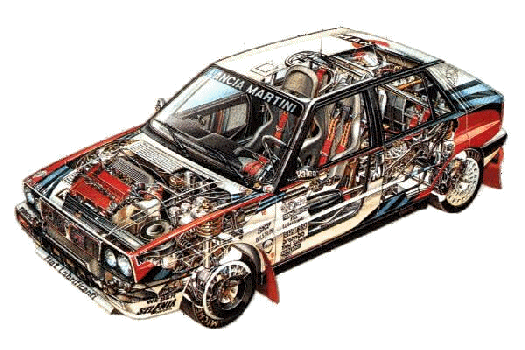
The Lancia Integrale 16V in its Group A version
The resemblance between the S4 and the Integrale stops at looks however. All other parts and car architecture are completely different. The Integrale sports a front, transversally mounted, 4 cylinder engine. The fact the engine is mounted transversally complicates the transmission layout for a 4 wheel drive car. It is particularly important that the shafts driving each wheel are of equal length. This is required to assure similar handling characteristics in both left and right corners. In the Integrale the problem is handled by mounting the gear box at the rear end of the engine (next to the left wheel) then using an internal axle to send back the power to the centrally mounted center differential. This, epicyclical, center differential uses a classic viscous coupler as a locking device and splits engine torque unequally between the front and rear axles.
The torque distribution between axles varies slightly between different Integrale versions. The first series of cars (Delta 4WD and Integrale 8V) use a 56/44 distribution favoring the front wheels. This undelrines the car’s front wheel drive heritage. The next series (Integrale 16V and evoluzione) use a 47/53 distribution favoring the rear wheels. The new torque distribution in 16V and evoluzione models was barely noticeable in every day driving conditions.
The Integrale’s short wheelbase, as compared to an Audi CoupĂ© Quattro or other similarly architectured cars, made it extremely versatile but also a bit nervous when above 180Km/h. Although some of the typical 4WD turbo charged car characteristics were still present (heavy understeer when entering corners followed by extreme oversteer when leaving the corner) the car had a huge potential, somewhat moderated by its soft, deformation prone chassis. Racing cars were prepared by Abarth (Fiat’s usual competition partner) who managed to produce rally cars that were light, reliable and powerful enough not to fear any opposition.
The street and competition versions of all the Delta Integrale series suffered a common weakness. The suspension travel was very limited and the cars behaved nervously on tarmac and not very efficiently on gravel. Unfortunately Lancia has never been able to fix this, mainly because the Integrale was based on an everyday car (the normal Delta) and FIA regulations prohibit radical suspension layout modifications. The Integrale’s suspension layout is a heritage of the rest of the Lancia Delta line. The front suspension is composed of a classic McPherson strut and lower wishbones. The rear suspension, pictured below, was not as sophisticated as on some more recent cars, is a very cleverly designed McPherson layout with double parallel transversal lower arms and a longitudinal track control arm.
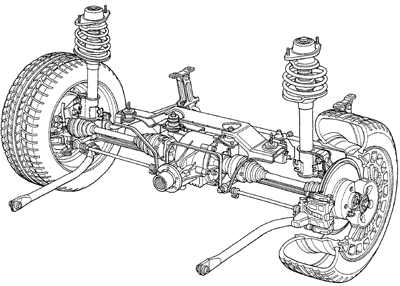
The Delta Integrale Evoluzione rear suspension
Although the general suspension layout did not change over the years and different Integrale models it did evolve with wider and stronger lower wishbones and longer rear control arms in the Evoluzione models. On all Integrale models Lancia managed to keep the unsprung weight to very low levels and this fact greatly contributes to the car’s exceptional handling abilities.
Most of all, the Delta Integrale arguably has the best steering feedback of any car ever produced. The car’s steering wheel is so communicative of what’s going on and what the car intends to do, so perfectly weighted and quick that almost anyone with a minimum experience is able to drive it at an extremely fast pace.
The street version of the Integrale has the typical road behavior of most 4 wheel drive supercharged cars. It understeers heavily when entering corners and oversteers when exiting. This behavior is, partly, due to the turbo lag phenomenon. When entering corners you normally have finished braking and the turbo is running in low revs. You have to accelerate heavily inside the corner while the car understeers and wait for the turbo to come in a more favorable rotational speed. When this happens a huge amount of torque hits the wheels, the front wheels cannot handle it, the center differential locks and sends torque to the rear wheels. This causes heavy oversteering when exiting a corner.
One has to get used to this “strange” and brutal road behavior. You must be especially brave not to fear the understeering phase of corner handling. When entering corners you really get the impression the car is heading straight out. Its at about halfway through the corner, provided your right foot is squeezing the gas pedal against the floor, that the turbo starts doing its thing. Then you are catapulted out of the curve at an unbelievable speed.
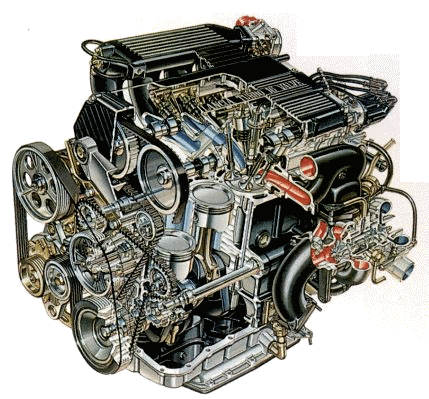
The Lancia Integrale 16V engine
The competition versions were equipped with bang-bang (A.L.S.) systems that dramatically reduce the turbo lag time and hence are able to render the car’s cornering abilities closer to those of, other, non-turbocharged cars. There have even been attempts of mounting such systems in street versions. Toyota had a system called Fresh Air Intake System mounted in the street version of the Celica GT4 but the system was deactivated in commercial vehicles due to excessive exhaust tube damages.
Once used to the road behavior of the Integrale, or any other 4WD turbocharged car for that matter, you realize there is no other type of vehicle that can corner faster. Especially impressive is the speed at which these cars are able to extract themselves from a corner. Unfortunately this type of vehicle is an endangered species heading straight to extinction for ecological and other obscure marketing reasons. If you’ve never driven a car using this architecture, and you are a car enthusiast, it is strongly recommended that you try one. One cannot really put into words the excitement and feeling of invulnerability these cars provide.
Speaking of invulnerability there is a catch however. The fact that these turbocharged cars are full time four wheel drive prohibits any action of the brake pedal, or even a sudden lift-off while in a corner. If , by misjudgment, one enters a corner too fast and decides to brake or even stop pushing the gas pedal then bad things are likely to happen. These actions almost always end in head to tail figures and damages. What happens when you brake a 4WD in a corner is that, since the front and rear axles are linked by differentials, engine torque transfers are operated at the first sign of wheel lock or spin. Depending on many parameters, such as suddenness or degree, this torque transfer can be difficult to manage. Rally drivers use this phenomenon to reduce the amount of understeering and thus ease cornering. An every day driver, even a very competent one, will have much more trouble dealing with the situation.
All versions of the Lancia Integrale, including the Delta 4WD, are equipped with a dynamic brake force proportioning device to counter the above mentioned behavior and avoid head to tail figures. The cars are fitted with a brake proportioning valve which is operated in real time and has the effect of adjusting the rear brake force bias depending on the angular position of the rear suspension’s trailing arms. The valve reduces the rear brake bias if the rear suspension arms present a negative angle (i.e. the car is braked hard enough to have the front suspension dive and the rear suspension rise) and amplifies it if the rear trailing arms angle is positive. The system is very efficient in the straight and avoids difficult to control figures in most braking situations. It is not very efficient inside corners, since in corners suspension angles vary rapidly and in opposite directions, and the driver must take care not to apply too much braking in those situations. The Integrale’s brake propositioning system was, of course, not mounted in the competition cars.
To put it in short the Lancia Integrale is a very dynamic and well behaved car in all but the most extreme driving conditions. It cannot compare, of course, with cars much younger such as the Subaru Impreza Turbo or the Mitsubishi Lancer Evolution which are much more posed and stable to limits well beyond those of the Lancia but keep in mind the the Delta was conceived at least a decade earlier. Additionally its Italian breed and charm make it a companion of choice for the car loving enthusiast.
Everyday life with a Lancia Delta Integrale
You must really love these cars in order to pass on the problems they introduce to your driver’s life. Integrales are so well behaved and dynamic on the road that they make you forget all the problems they bring along (much like most other Italian cars of the same era).
You must put up with intermittent and unexplainable electrical problems. One that makes me laugh (sometimes) is the windshield wipers being inoperative when it rains (they work fine though in dry weather). Another interesting marvel I have experienced with them is the fuel being cut-off in hot weather. Lancia “explained” this by saying that the Swiss fuel is so volatile it starts boiling in the tank when the weather is hot. This results in air bubbles getting into the fuel circuit which, in turn, cuts-off ?! When this happens the engine stops and it usually takes an hour or two before the darn thing starts again. Then there’s the rust problem (but you must really not take care of the chassis for rust to appear), then the delicate engine, then the sublte smell of gear box oil, then….Most of the engine brittleness problems were solved on the Evoluzione II version with a more advanced ECU, better sensors to detect engine knock and the like. Note that the Evoluzione II was built under license by a contractor company, Maggiora in Chivasso near Turin, not Lancia, thus sorting out most of the electrical and finishing quality problems. Production of the Delta Integrale ceased in 1994 and all Maggiora facilities where used to build the Fiat Barchetta.
If you own a Delta Integrale or you are thinking about buying one drop by the Evo Corner discussion forum for more information on the various versions of the Lancia Delta Integrale at: Delphi
If you’re in the market for a Delta Integrale, especially the Evoluzione II Cat a.k.a. Evoluzione III, but any model will do, you should have no second thoughts. There are quite a few available all over Europe at decent prices, but you must be aware of the slight inconveniences mentioned above. You have been warned, the Lancia Delta Integrale is not a “normal” everyday car. It’s a joy toy and it requires love. And above all it has a few advantages over other cars in its class: a unique pedigree and its Italian breed which no other contender in that market will ever have.
Read more about 4WD turbo charged cars technical background here and about their dynamics here.

